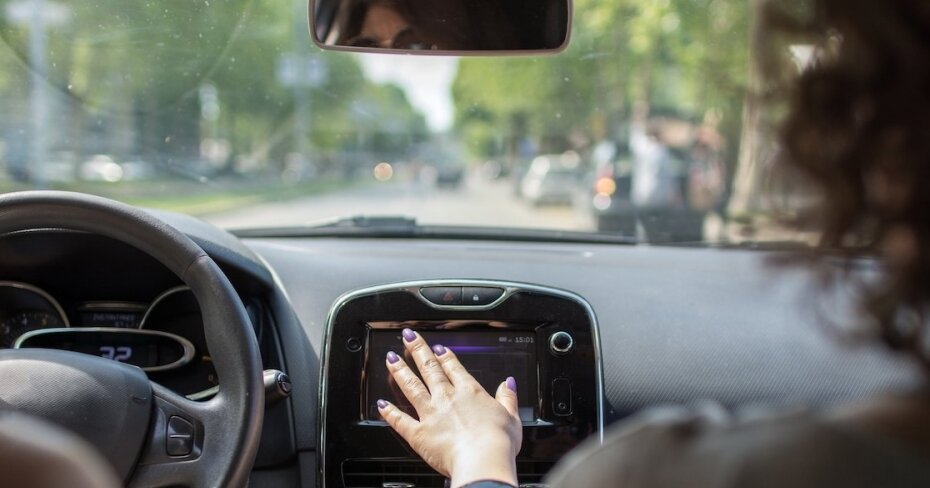Touch screens in cars are distracting, so why do we keep putting them there?
By: Lisa Coxon on October 18, 2019
When we think about distracted driving, we almost exclusively think about cell phone use.
And for good reason. More than 50% of Canadians admit that they’ve driven while distracted by their phones at least once, according to survey data from Desjardins — a number that’s risen from 38% in 2018.
According to Ontario’s Ministry of Transportation, deaths from crashes caused by distracted driving have doubled since 2000. In fact, someone who uses their phone while they drive is four times more likely to crash than someone who doesn’t.
But what’s less likely to come to mind when we think about distracted driving is how distracting the vehicle is itself.
Daniel McGehee knows a thing or two about this. He’s a human factors engineer and director of the National Advanced Driving Simulator at the University of Iowa, where he studies distracted driving and specializes in figuring out how to design vehicle interfaces around human limitations, such as memory and vision.
If you were invited to participate in his research, McGehee and his team of around 40 people would invite you into their driving simulator lab (the largest in the world) and sit you down behind the wheel of a vehicle simulator. Next, they might attach to your noggin a headband with a small light that dangles in your periphery, or place a small buzzer on your shoulder. As you begin to drive, they’d have you complete a task, such as changing the radio station. While you’re doing that, they might blink the light and buzz the buzzer, then ask you to press a button on the steering wheel whenever you see or feel either of these stimuli. Or maybe they’d ask you to make a restaurant reservation using an app on the dashboard touch screen and measure how long it takes you, and how many errors you make in the process.
Research like McGehee’s has revealed a less-talked-about fact: dashboard touch screens also distract us while we drive.
In fact, in a Desjardins survey from earlier this year, 41% of those polled said that changing their vehicle’s console/infotainment system distracted them while driving. And a recent AAA study confirmed that touch screens are especially distracting the older we get, with seniors taking their eyes off the road to fiddle with infotainment systems for an average of eight seconds longer than younger drivers. Even the National Safety Council says dashboard touch screens “pose a threat to our safety.”
If distracted driving is such a problem — and something that auto insurance companies are increasingly turning away consumers for — then why do we keep manufacturing our vehicles with built-in distractions?
Cheaper to install than physical knobs and buttons
Surprisingly, the first iteration of the touch screen infotainment system dates all the way back to 1988, when the first one was installed in the Oldsmobile Toronado. The screen’s features weren’t too wild by today’s standards — some radio information, heating, ventilation, and cooling. But for 1988, McGehee says, “It was bristling with technology. For General Motors, it was really their demonstrator car.”
Back then, the technology used to power the dashboard touch screen was costly. But now that we live in an almost exclusively digital world, where something like a backup camera is standard across vehicle manufacturers, McGehee says that’s no longer the case. As soon as a technology becomes ubiquitous, he says, it also becomes ubiquitously inexpensive.
“The more you can eliminate any buttons, the cheaper it is for you to manufacture.”
That’s because the interface for dashboard touch screens is pretty standard across all vehicle platforms. The touch screen from one supplier can fit inside all levels of vehicles, whereas physical knobs have to be different for each make and model because they feature a different backend.
“In principal, touch screens can be more expensive but not in the volume manufacturers are buying,” says McGehee. “The standardization makes things much cheaper.”
Less distracting to drivers than cell phones
The other reason manufacturers keep screenifying our vehicles has to do, ironically, with safety.
“We’re completely addicted to our phones,” says McGehee. “In our research on naturalistic driving where we put cameras in your car and can see how you operate your vehicle, we can show that many people will rustle in their pocket or their purse right when they have to make a complicated merge to read a text message, even though it’s a completely inappropriate time to read. We see that time and time again — the power of the phone and this addiction.”
And the tricky thing about an addicted driver audience is that they demand certain features in their vehicles that allow them to stay — or at least feel — connected to their phone. Things like being able to use their Spotify app, for instance, or using Google Maps. “Consumers expect this kind of access,” says McGehee.
So while 30 years ago, dashboard touch screens were all about the cool factor, part of the reason why manufacturers keep building vehicles with this kind of technology is actually to keep you off your phone while you drive. This might seem like trading smoking for vaping, since dashboard touch screens are akin to having a giant cell phone or tablet in your eyeline while you drive, but with the appetite for cell phone-related distraction so prevalent, they’re actually a safer alternative.
“Are touch screens in cars distracting?” says McGehee. “Yes they are. But cell phones are much more distracting.”
“It’s very hard to read a cell phone,” he says. “The font sizes are generally very small. The buttons are small, so it takes a lot of effort to manipulate that phone.”
That said, touch screens aren’t a perfect alternative, since they require much more mental mapping.
“With a volume knob,” says McGehee, “you can be looking straight ahead while you're driving, reach down and turn down the volume without looking at the knob. You sort of map out in your reach and your touch. With a touch screen, you have to look at the button first, then move your hand to it, make sure that your finger is on it, make the input and then look forward. So if you look at the number of glances and the duration of glance to do that operation, it’s much more demanding to do that with a touch screen.”
Auto manufacturers have to take this into consideration when they install touch screens in vehicles. There are strict guidelines set in place by Transport Canada surrounding touch screen infotainment systems and driver distraction. “There are concerns that distracted driving is increasing due to the various technologies in vehicles, which present more types and amounts of information to drivers than before,” the website says.
“There are many things that are distracting while we drive,” says McGehee, “and touch screens are one of them. But again, the alternative is you’re going to use your phone and we want you to stay off your phone.”
Could touch screens ever affect auto insurance rates?
Dashboard touch screens might not be as distracting as cell phones, but if they’re distracting at all, why aren’t regulators doing anything about it?
According to an emailed statement from Malon Edwards, a spokesperson for the Financial Services Regulatory Authority of Ontario (FSRA), “the issue of distracted driving falls under the local police and wouldn’t be a matter for FSRA.”
And, when it comes to setting auto insurance premiums based on how distracting a dashboard touch screen is, Edwards said “this wouldn’t be for us but the manufacturer, auto industry or insurance companies.”
There may not be a clear link between dashboard touch screens and distracted driving crashes, but auto insurance companies are keeping an eye on these systems.
“Anything that takes a driver’s attention away from the road can be considered a distraction,” said Kevin Smart, AVP of Personal Insurance Underwriting Policy at Aviva Canada, in an email.
“Aviva encourages every driver to always maintain full awareness and control of their vehicle, and to put the safety of others ahead of any potential distractions, including infotainment systems. While there is not enough data to clearly point to touch screens as a risky feature, we continue to monitor our loss data to see if there is a trend.”
Could we ever see higher premiums for vehicles with dashboard that are solely reliant on touchscreen engagement?
“...there is a potential impact of higher insurance premiums for vehicles with touchscreen devices if we see evidence of a growing number of claims frequency for the vehicle make, model and year,” Smart says.
“In other words, if a certain type of vehicle gets into accidents more often than others, it costs more to insure, and drivers of those vehicles may expect to see higher premiums in the future.”


